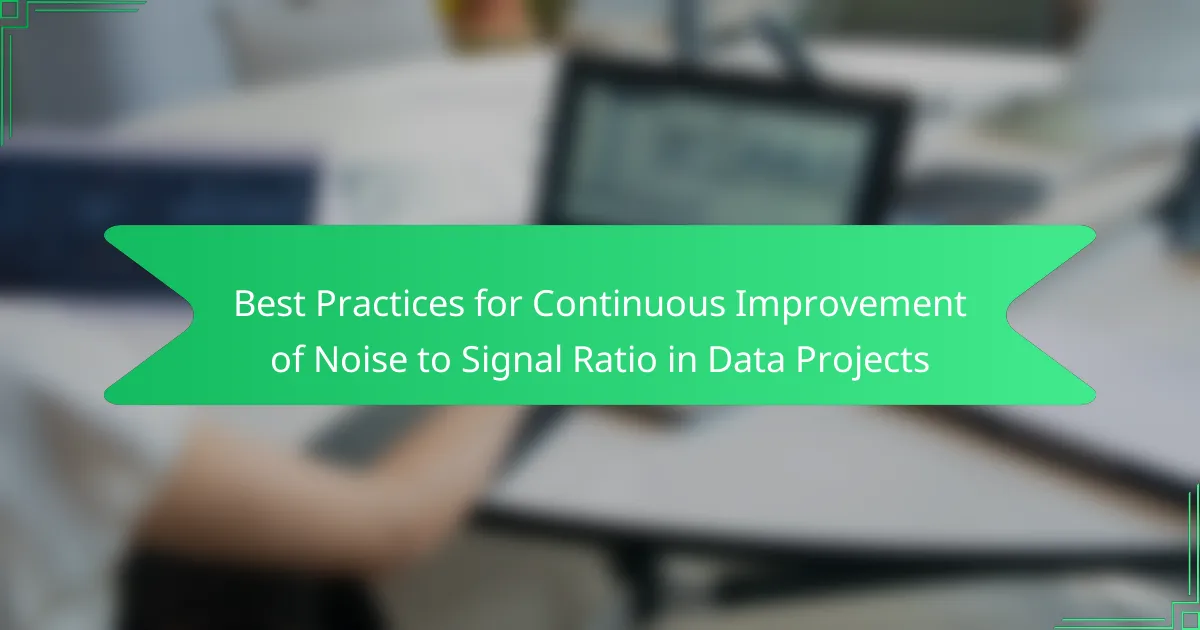Enhancing the noise to signal ratio in data projects is essential for achieving accurate and meaningful insights. By implementing best practices such as data cleansing, feature selection, and regular audits, organizations can significantly improve data quality and relevance. These systematic strategies not only refine the data but also bolster decision-making processes and analytical outcomes.

What are the best practices for improving noise to signal ratio in data projects?
Improving the noise to signal ratio in data projects involves systematic strategies to enhance data quality and relevance. Key practices include data cleansing, feature selection, advanced analytics, feedback loops, and regular audits to ensure that the data used is both accurate and meaningful.
Data cleansing techniques
Data cleansing is essential for reducing noise in datasets. Techniques such as removing duplicates, correcting inaccuracies, and standardizing formats help ensure that the data accurately reflects the reality it is meant to represent. For example, using tools to identify and eliminate duplicate entries can significantly enhance the reliability of analysis.
Additionally, employing outlier detection methods can help identify and rectify anomalies that may skew results. Regularly updating and validating data sources is crucial to maintain a high-quality dataset.
Feature selection methods
Feature selection involves identifying the most relevant variables that contribute to the predictive power of a model. Techniques such as recursive feature elimination or using algorithms like LASSO can help in selecting features that enhance the signal while minimizing noise. This process can lead to simpler models that are easier to interpret and often perform better.
It is advisable to use domain knowledge to guide feature selection, ensuring that chosen features align with the project’s objectives. Avoid including irrelevant features, as they can introduce unnecessary complexity and reduce model performance.
Utilizing advanced analytics tools
Advanced analytics tools can significantly improve the noise to signal ratio by applying sophisticated algorithms and machine learning techniques. Tools like Python’s Scikit-learn or R’s caret package offer a range of methods for data analysis, including dimensionality reduction techniques like PCA (Principal Component Analysis) that help in isolating the signal from noise.
When selecting tools, consider their compatibility with your existing data infrastructure and the specific needs of your project. Training team members on these tools can also enhance their effectiveness in improving data quality.
Implementing feedback loops
Feedback loops are critical for continuous improvement in data projects. By regularly collecting feedback from end-users and stakeholders, teams can identify areas where data quality may be lacking and make necessary adjustments. This iterative process helps in refining data collection methods and improving overall project outcomes.
Establishing clear communication channels for feedback ensures that insights are acted upon promptly. Regularly scheduled reviews can help maintain focus on improving the noise to signal ratio throughout the project lifecycle.
Regular data audits
Conducting regular data audits is a proactive approach to maintaining data integrity and relevance. These audits should assess data accuracy, completeness, and consistency, identifying any discrepancies that may introduce noise. A well-structured audit process can include automated checks and manual reviews to ensure thoroughness.
Establishing a routine for data audits, such as quarterly or biannual reviews, can help organizations stay ahead of potential issues. Documenting findings and actions taken during audits can also provide valuable insights for future projects.

How can organizations implement data cleansing?
Organizations can implement data cleansing by establishing systematic processes to identify and rectify inaccuracies in their datasets. This enhances data quality, leading to improved decision-making and analysis.
Automated data cleaning tools
Automated data cleaning tools utilize algorithms to detect and correct errors in datasets without manual intervention. These tools can efficiently handle large volumes of data, identifying duplicates, inconsistencies, and missing values.
Examples of popular automated tools include OpenRefine, Talend, and Trifacta. When selecting a tool, consider factors such as integration capabilities, user interface, and the specific types of data issues you need to address.
Manual data review processes
Manual data review processes involve human oversight to ensure data accuracy and relevance. This approach is particularly useful for complex datasets where context is crucial for understanding data quality issues.
To implement a manual review, establish a checklist for common data errors and assign team members to regularly audit data entries. This can help catch errors that automated tools might miss, but it is time-consuming and may not scale well for large datasets.

What role does feature selection play in data projects?
Feature selection is crucial in data projects as it helps identify and retain the most relevant variables, improving the overall quality of the analysis. By eliminating irrelevant or redundant features, it enhances the model’s performance and reduces noise in the data.
Reducing dimensionality
Reducing dimensionality through feature selection simplifies the dataset, making it easier to visualize and analyze. Techniques such as Principal Component Analysis (PCA) or Recursive Feature Elimination (RFE) can be employed to achieve this. Aim to retain around 70-90% of the variance while reducing the number of features to avoid overfitting.
When selecting features, consider the trade-off between model complexity and interpretability. Fewer features can lead to faster computation times and clearer insights, but ensure that essential information is not lost in the process.
Improving model accuracy
Feature selection directly impacts model accuracy by focusing on the most informative variables. By using methods like correlation analysis or feature importance scores from tree-based models, you can prioritize features that contribute significantly to the predictive power of your model.
Regularly validate the model’s performance using techniques like cross-validation to ensure that the selected features genuinely enhance accuracy. Avoid common pitfalls such as relying solely on automated selection methods without domain knowledge, as this can lead to suboptimal feature choices.

Which advanced analytics tools enhance signal clarity?
Advanced analytics tools that enhance signal clarity focus on reducing noise and improving the quality of insights derived from data. These tools help in visualizing data effectively and performing in-depth analysis to extract meaningful signals from complex datasets.
Tableau for visualization
Tableau is a powerful data visualization tool that allows users to create interactive and shareable dashboards. By transforming raw data into visually appealing graphics, Tableau helps highlight key trends and patterns, making it easier to identify significant signals amidst noise.
When using Tableau, consider employing filters and parameters to focus on specific data segments. This can help eliminate irrelevant information and enhance clarity. Additionally, using color coding and annotations can guide viewers to important insights quickly.
Python libraries for data analysis
Python offers several libraries, such as Pandas, NumPy, and SciPy, that are essential for data analysis. These libraries provide functions for data manipulation, statistical analysis, and numerical computations, allowing users to refine their datasets and improve signal clarity.
To enhance signal clarity using Python, start by cleaning your data to remove outliers and missing values. Utilize visualization libraries like Matplotlib or Seaborn to plot your data and identify trends. Remember to document your analysis process to ensure reproducibility and clarity in your findings.

What are effective feedback loops in data projects?
Effective feedback loops in data projects involve systematic processes for gathering insights and making adjustments based on stakeholder input and testing results. These loops help enhance the noise to signal ratio by ensuring that data-driven decisions are informed and continuously refined.
Stakeholder input mechanisms
Stakeholder input mechanisms are essential for capturing diverse perspectives and requirements throughout a data project. Techniques such as surveys, interviews, and focus groups can be employed to gather qualitative and quantitative feedback from users and decision-makers.
To maximize effectiveness, ensure that feedback is solicited at various stages of the project, particularly during initial planning and after key milestones. This approach helps identify misalignments early and allows for timely adjustments, ultimately improving project outcomes.
Iterative testing and validation
Iterative testing and validation involve continuously assessing the performance of data models and processes through repeated cycles of testing and refinement. This method allows teams to identify issues, validate assumptions, and enhance the overall quality of the data outputs.
Implementing a structured testing framework, such as A/B testing or cross-validation, can help quantify improvements and ensure that changes lead to meaningful enhancements. Regularly scheduled reviews, ideally every few weeks, can keep the project aligned with stakeholder expectations and project goals.

How often should data audits be conducted?
Data audits should be conducted regularly to ensure the integrity and quality of data. Typically, organizations benefit from a combination of quarterly audits and annual comprehensive reviews to maintain a high noise to signal ratio in their data projects.
Quarterly audits
Quarterly audits focus on identifying and addressing immediate data quality issues. These audits can help detect anomalies, inconsistencies, or errors that may arise due to changes in data sources or collection methods.
During quarterly audits, teams should review key performance indicators (KPIs) and assess data accuracy against established benchmarks. This process often involves checking data entry processes, validating data against source documents, and ensuring compliance with relevant standards.
Annual comprehensive reviews
Annual comprehensive reviews provide a broader evaluation of data management practices and overall data strategy. These reviews should encompass a thorough analysis of data governance, security protocols, and long-term data quality trends.
In an annual review, organizations should assess the effectiveness of data collection methods, evaluate the impact of any changes made throughout the year, and establish new goals for the upcoming period. This is also an opportunity to engage stakeholders and ensure alignment with organizational objectives.










